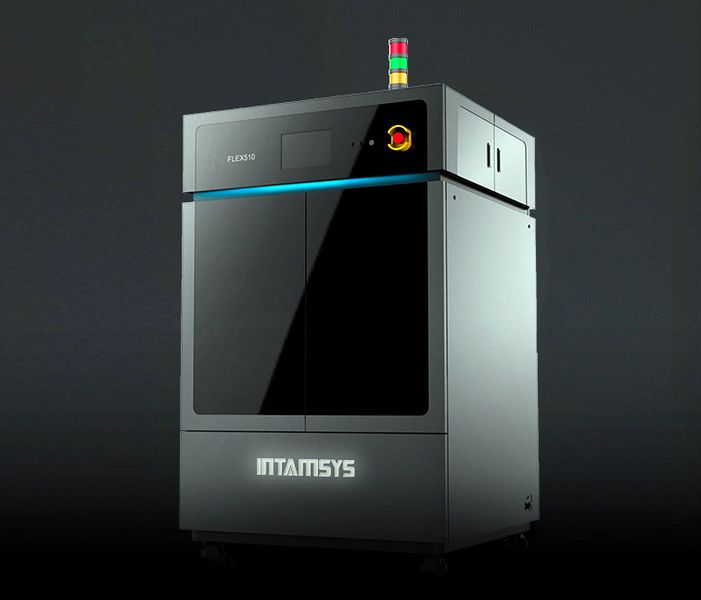
SPONSORED CONTENT
INTAMSYS announced a radically new 3D printer, the FLEX 510, which is able to 3D print flexible objects at very high speeds.
I say “radical” because this is quite a departure for INTAMSYS, as they have been successfully focused on high-temperature production 3D printing for quite some time.
Now the company has developed a new device that is capable of 3D printing very challenging flexible filaments. The new FLEX 510 is designed specifically for production of sporting goods, fashion design and even healthcare equipment, all of which frequently require flexible materials.
3D Printing Flexible Materials
Flexible materials have been a constant issue for 3D printing, as they are notoriously challenging to print. This is because their spaghetti-like form is difficult to push with an extruder, as the soft filaments simply bend instead of heading where they are supposed to go.
This problem is exacerbated by Bowden-style 3D printers, which have a very long filament path between the extruder and hot end. Unless the flexible filament is relatively “hard”, they simply cannot be 3D printed on Bowden equipment.
On direct drive extruders there are still problems: if the filament is pushed at too high a speed it can crumple up in the short gap between the extruder gears and hot end. The resolution for this dilemma is to 3D print flexible filaments at very slow speeds.
Therefore we see flexible filament often successfully 3D printed on direct drive 3D printers, but always at an very slow speed, sometimes only 25% of normal speeds.
There’s another issue: hot ends. By definition, flexible filaments are sticky and adhere to metal. If you have an “all metal” hot end that’s designed for higher-temperature materials you’ll probably find it jams frequently when attempting to 3D print flexible filament. For this reason two types of hot ends are normally used: one for soft, low-temperature and flexible materials, and one for more rigid higher-temperature materials. This is a problem if your 3D printer has only one hot end, as you’ll have to physically swap hot ends.
INTAMSYS FLEX 510 3D Printer

The new FLEX 510 3D Printer solves all of these issues in a new machine design. The key feature of the device seems to be its High Speed Flexible Material Extrusion (HSFE) technology. This is a method of extruding flexible material that allows for high speeds. INTAMSYS says it can be 5X faster than typical flexible print speeds on other machines.
I’m not yet sure how they’ve accomplished this, but it likely has to do with a specific configuration of gearing and filament path design, along with careful tuning of speeds and temperatures.
But that’s not all: the FLEX 510 includes several other very interesting features that, when combined, provide a powerful platform for flexible part production.
One of the most interesting features is their “Smart eXtruder Bay System” (SXBS), which allows the device to easily switch materials during 3D printing. The FLEX 510 can have up to four different materials available during 3D printing, and these are deployed to the two independent extruders via SXBS as required during print jobs.
This means that you could, for example, 3D print a single object in up to four different materials. The materials could be either four different colors, or materials with different shore hardness values. One possibility would be to 3D print a shoe midsole that has several different regions of differing hardness to produce optimum running performance.

The FLEX 510 inherits much of the production nature of its fellow INTAMSYS 3D printers, including a very informative color touchscreen and “active automatic leveling technology” that should make it easy to use.
While the FLEX 510 is focused on 3D printing flexible materials, it apparently does have the capability of 3D printing other “normal” 3D print materials, like PLA or ABS, if the nozzles are changed. However, that’s an unlikely scenario as one’s goal of acquiring a FLEX 510 is to 3D print flexible materials.
Here is a short video showing the highlights of the new FLEX 510 3D printer:
I asked INTAMSYS representatives about the materials used in the FLEX 510 and was reassured that it is indeed an open materials machine and that any third party flexible filament could be used, so long as it has been certified by INTAMSYS.
Flexible 3D Print Production
The combination of all these features should make for a powerful 3D printer that can legitimately be used for production purposes. The higher print speeds is a key factor in production, as the number of prints that one could achieve per week is significantly increased over other 3D printers using flexible material.
The INTAMSYS FLEX 510 is available now, but INTAMSYS is most interested in collaborating with clients on new flexible 3D print applications. For details on that and pricing, please contact INTAMSYS directly.
Via INTAMSYS
